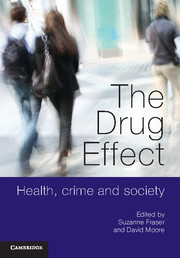Book contents
- Frontmatter
- Contents
- List of contributors
- Acknowledgements
- Introduction
- Part 1 Drug use as social and cultural practice
- Part 2 Drugs, health and the medicalisation of addiction
- 5 Beyond the ‘potsherd’
- 6 Drugs that work
- 7 From ‘magic bullets’ to medical maintenance
- 8 Pharmacotherapy as social policy, or, the public and private worlds of welfare capitalism
- Part 3 Drugs, crime and the law
- Index
- References
7 - From ‘magic bullets’ to medical maintenance
The changing meanings of medical approaches to drug use in US drug policy
from Part 2 - Drugs, health and the medicalisation of addiction
- Frontmatter
- Contents
- List of contributors
- Acknowledgements
- Introduction
- Part 1 Drug use as social and cultural practice
- Part 2 Drugs, health and the medicalisation of addiction
- 5 Beyond the ‘potsherd’
- 6 Drugs that work
- 7 From ‘magic bullets’ to medical maintenance
- 8 Pharmacotherapy as social policy, or, the public and private worlds of welfare capitalism
- Part 3 Drugs, crime and the law
- Index
- References
Summary
Multiple meanings are condensed in the term ‘medicalisation’; these change over time in relation to the ‘technologies of addiction’ on offer. Technologies used to treat addiction have ranged from specific pharmacotherapies to drug-free ‘therapeutic communities’ (TCs) and recovery-oriented self-help groups. Recent medical approaches focus on specific pharmacotherapies that, in the language of medicalisation, target receptor sites in the brain, helping shift US drug policy away from the tenets of abstinence upon which it is premised. After a brief experiment with municipal morphine maintenance clinics in the first two decades of the twentieth century, abstinence from all illegal substances was adopted as the over-riding mark of individual morality and the goal of a moral society. US drug policy became profoundly anti-maintenance. Maintenance has been continually constructed not as a treatment modality but as tantamount to condoning drug use, being ‘soft on addicts’ and ‘substituting’ one addictive drug for another. Despite the anti-maintenance stance, hopes that pharmacotherapy could displace drug users’ reliance on illegal substances have been embraced in the ethos of ‘pharmacological optimism’ that has pervaded four distinct eras in the development of drug policy in the United States (see ‘Eras in US drug policy development’ below).
This chapter tells the story of the recent convergence of ‘medicalisation’, medication and maintenance by focusing on prevailing forms of ‘pharmacological optimism’ – the idea that a pharmacotherapy could be developed to displace the problematic substance to which subjects are addicted. The dream of pharmacological optimism reconfigured social infrastructure and medical practice in each era.
- Type
- Chapter
- Information
- The Drug EffectHealth, Crime and Society, pp. 122 - 136Publisher: Cambridge University PressPrint publication year: 2011
References
- 3
- Cited by



